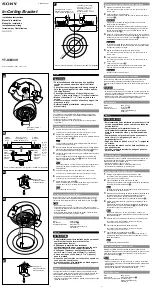
AWM-W Page 2 of 2
1. Mount the Wall Bracket to the Wall
No portion of this document or any artwork contained herein should be reproduced in any way without
the express written consent of Atdec Pty Ltd. Due to continuing product development, the manufacturer
reserves the right to alter specifications without notice. ©
20230120B
x2
Using the
Single Wall
Bracket as
a template,
mark the
two fixing
hole positions
for drilling.
NOTE:
On a timber
stud wall, use a good
quality stud finder to
position mounting
fasteners in the
centre of studs.
NOTE:
Wall bracket
must be level. Verify
using a quality spirit
level tool positioned
along the side edge
of the wall bracket.
2. (Optional) Set arm rotation to 360°
Note rotation is set to 180
°
by default. This will protect the wall by preventing the arm swinging into it.
2.1.
Remove plastic sleeve from
wall bracket
2.2.
Remove rotation ring.
1. Press
2. Lift
2.3.
Place rotation ring in desired
position and replace plastic sleeve.
180°
360°
OR
Default
Position
Flipped
Position
3. Fit arm to Single Wall Bracket
3.2.
Ensure arm is fully
pushed onto bracket.
3.1.
Push arm onto
the wall bracket
shaft. Ensure grub
screw is retracted
before doing so.
3.3.
Tighten the set screw
with 4mm Hex Key (supplied
with arm) to secure the arm
in place.
NOTE:
Check the joint rotation
is smooth after tightening.
IMPORTANT:
Ensure plastic
sleeve is fitted
on wall bracket.
NOTE:
• Alternative wall constructions,
such as masonry, will require
different fasteners than what is
supplied with the product.
• Selection and sourcing of
alternative wall mounting fasteners
is the responsibility of the installer.
See ‘Important Information’ above
for more details.
Timber Stud
NOTE:
Thickness of sheeting and cladding
over the timber stud, including plaster
board, should not exceed 15mm (
⅝
”).
70mm (2
3
/
4
”)
Stud
(
5
/
32
”)
4mm




















